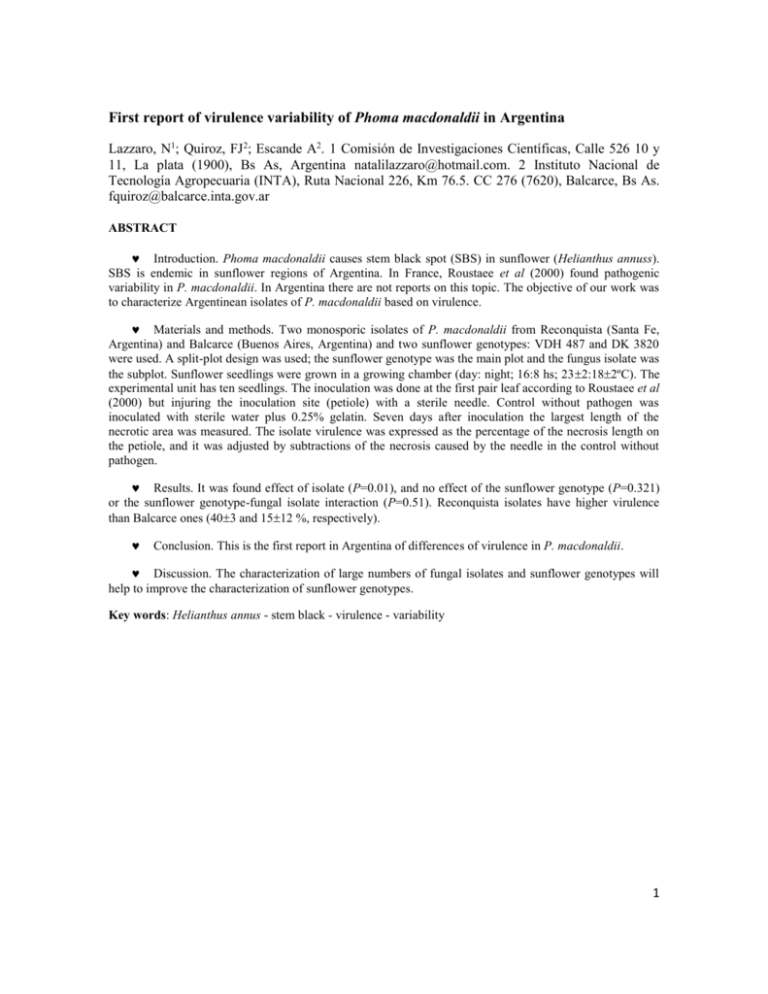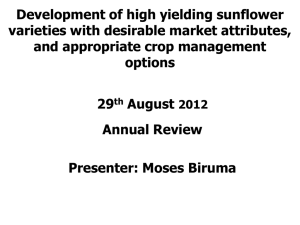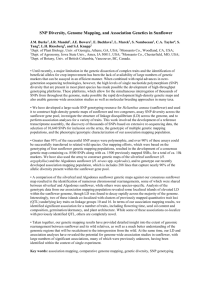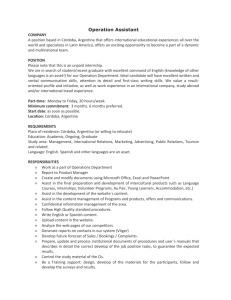First report of virulence variability of Phoma macdonaldii in
advertisement

First report of virulence variability of Phoma macdonaldii in Argentina Lazzaro, N1; Quiroz, FJ2; Escande A2. 1 Comisión de Investigaciones Científicas, Calle 526 10 y 11, La plata (1900), Bs As, Argentina natalilazzaro@hotmail.com. 2 Instituto Nacional de Tecnología Agropecuaria (INTA), Ruta Nacional 226, Km 76.5. CC 276 (7620), Balcarce, Bs As. fquiroz@balcarce.inta.gov.ar ABSTRACT Introduction. Phoma macdonaldii causes stem black spot (SBS) in sunflower (Helianthus annuss). SBS is endemic in sunflower regions of Argentina. In France, Roustaee et al (2000) found pathogenic variability in P. macdonaldii. In Argentina there are not reports on this topic. The objective of our work was to characterize Argentinean isolates of P. macdonaldii based on virulence. Materials and methods. Two monosporic isolates of P. macdonaldii from Reconquista (Santa Fe, Argentina) and Balcarce (Buenos Aires, Argentina) and two sunflower genotypes: VDH 487 and DK 3820 were used. A split-plot design was used; the sunflower genotype was the main plot and the fungus isolate was the subplot. Sunflower seedlings were grown in a growing chamber (day: night; 16:8 hs; 232:182ºC). The experimental unit has ten seedlings. The inoculation was done at the first pair leaf according to Roustaee et al (2000) but injuring the inoculation site (petiole) with a sterile needle. Control without pathogen was inoculated with sterile water plus 0.25% gelatin. Seven days after inoculation the largest length of the necrotic area was measured. The isolate virulence was expressed as the percentage of the necrosis length on the petiole, and it was adjusted by subtractions of the necrosis caused by the needle in the control without pathogen. Results. It was found effect of isolate (P=0.01), and no effect of the sunflower genotype (P=0.321) or the sunflower genotype-fungal isolate interaction (P=0.51). Reconquista isolates have higher virulence than Balcarce ones (403 and 1512 %, respectively). Conclusion. This is the first report in Argentina of differences of virulence in P. macdonaldii. Discussion. The characterization of large numbers of fungal isolates and sunflower genotypes will help to improve the characterization of sunflower genotypes. Key words: Helianthus annus - stem black - virulence - variability 1 INTRODUCTION The stem black spot (SBS) in sunflower is caused by the Phoma macdonaldii (sexual phace: Leptosphaeria lindquistii Frezzi). This disease has become an endemic in all countries where sunflower is grown (Acimovic, 1984) and in all the Sunflower Region in Argentina (Pereyra and Escande, 1994). In the Republic of Argentina (RA) the land sown with sunflower extends from Chaco in the North with sub-tropical weather, to the south of pampas regions with temperate weather, Buenos Aires province is the main sunflower producing area of the total Argentina’s sunflower production In this context, management practices such as no-till systems, short- term crop rotations, intensified use of fertilizers as well as the use of few genotypes and a tendency to produce according to area, have allowed an increase in foliar and stem diseases in sunflower. Among these with recorded yield losses of up to 30% due to Phoma Black Stem (Velasquez and Fomento, 2003) A typical symptom of this disease is the appearance of black spots with well-defined edges (Velasquez and Formento, 2003), known as “black shield”. Although these spots usually appear on the stem, they can sometimes appear on the leaves (Gulya et.al., 1997) Different genotypes have been identified showing various degrees of resistance to SBS in sunflower and transmission to F1 hybrids (Roustaee et al., (a), 2000; Gulya et al., 1997). Perest et al., 1994 found differences in resistance and susceptibility to Phoma in sunflower in France. Roustaee et al., 2000 b y Darvishzadeh et al., 2007 supported these findings working on seedlings (method developed by Roustaee et al 2000b), and detecting a genotype-isolate interaction of P. macdonaldii coming from different locations in France, with a high correlation in adult plants. In Argentina, commercialized hybrids do not present total resistance to this disease. This pathogen is generally spread by pycnidiospores (asexual phase) that are water or air borne (Gulya et al., 1997). The reception of these pycnidiospores can happen at any stage and they usually become apparent at flowering (Melero Vara and Alonso, 1988). Roustaee et.al. (2000 a) determined that infection can be direct or through its stomata, working with inoculation in the petiole of cotyledons followed by necrosis. Roustaee et al (2000 b) showed the differences among French isolates in terms of in vitro growth rate, pycnidia morphology, picnidiogenesis, pigmentation and degree of aggressiveness. In Argentina there is no information about the variability of this pathogen. The objective of this study is to assess the variability of isolates of P. macdonaldii present in Argentina and the effect of different variants of P. macdonaldii on commercialized sunflower hybrids. The present study is grounded on the following hypothesis: P. macdonaldii isolates from Argentina vary in pathogenicity. MATERIALS Y METHODS Spore isolates of P. macdonaldii coming from Balcarce (B-Buenos Aires, Argentina) and Reconquista (RSanta Fe, Argentina) were used together with two sunflower genotypes: VDH 487 and DK 3820, that under natural inoculation differ in response. The experimental design comprised a divided plot, where the main plot corresponded to sunflower genotype and the subplot to the isolate. Seedlings were produced under chamber regulated at 232ºC y 182ºC light y dark period respectly; 16 hs light/8hs dark, 270 µmol photons/m2.s2 of radiation) and irrigated with nutritious solution (Hogland, 1957). Ten seedlings were inoculated at the first pair of leaves stage with 20 µl of suspension containing 106 pycnidiospores/ml following protocols in Roustaee et al (2000a) modified by the incorporation of a wound in the cotyledon petiole made with a sterile needle. The seedlings were covered with transparent polyethylene for 72 hours to favor the development of the disease. Sterile water with 0,25% agar was used as control. 2 Seven days after inoculation, the biggest length in mm of the necrotic area was recorded using a graded ruler. Aggressiveness of isolates was expressed as percentage of necrosis in relation to total length of the inoculated petiole. These values were checked against the control. Data were analyzed by variance analysis and the treatments were compared following LSD Fisher with an alfa of 0.05. Normality of data was checked by means of the Shapiro-Wilks test (alfa 0.01) RESULTS Effect of isolate was found (p=0.01) with the isolate from Reconquista being more aggressive than the one from Balcarce with 40 3% and 15 12 % of aggressivemennes respectly (Graphic 1). Effects of genotype (p=0,321) or genotype-isolate were not detected (p=0.51). Aggressiveness in % 60 50 40 30 20 10 0 B VDH 487 B R R DK3820 VDH 487 DK3820 Isolates of P. macdonaldii and genotypes Graphic 1: Aggressiveness of isolates de P. macdonaldii, measured as a percentage of necrotic petiole. B corresponds to the isolation of Balcarce, Buenos Aires, Argentina and R from Reconquista, Santa Fe, Argentina.Vertical bars represent standard error. DISCUSSION Differences are expected in the response of isolates coming from diverses localitations how Reconquista, Santa Fe and Balcarce, Bs. As., where the conditions for crop development are contrasting so the P. macdonaldii is adapted in each zone. This is the first report on variability in pathogenicity of isolates of P. macdonaldii in Argentina. In agreement with reports in France, differences in aggressiveness and morphological characteristics of monosporic P. macdonaldii isolates coming from diverse locations have been identified (Roustaee et al 2000, b). The detection of variability in aggressiveness will allow a better understanding and control of the disease in the different climatic areas in Argentina. In opposition to data provided by Darvishzadeh et al. 2007 there was no evidence of an existing genotype-isolate interaction. This experience should be replicated using lines (progeny lines) from the Banco de Germoplasma from INTA since there is evidence of variability in the response of French lines (Roustaee et al 2000 a). Probably the response of VDH 487 and DK3820 was not expected, because in this study with the inoculation method used only the invasion of the fungus was measure in contrast to the natural inoculation includes the penetration. 3 Using only two isolates and two genotypes selected for the present study allowed the detection of variants of the pathogen and the adjustment of the inoculation methodology. This study should be extended to achieve a deeper knowledge of the P. macdonaldii – sunflower genotype interaction. Characterization of a bigger number of isolates and genotypes will enable the identification of pattern strains and source of resistance to P. macdonaldii. BIBLIOGRAFÍA Asagir, 2008. El girasol. Importancia Económica [En línea] <http://www.asagir.org.ar/asagir2008/importancia-economica.asp> [Consulta: 25 septiembre 2009] Acimovic M. 1984. Sunflower diseases in Europe, the United State and Australia, 1981-1983. Helia, 7:45-54. Darvishzadeh R, Dechamp-Guillaume G, Hewezi T, Sarrafii A. 2007. Genotype-isolate interaction for resistence to black stem in sunflower (Helianthus annuus). Plant Pathology 56, 654-660. Gulya TJ, Rashid K y Marisevic SM., 1997. Sunflower Diseases. En: Schneiter AA. Sunflower technology production. ASA. CSSA, SSSA. Madison, WI, USA. pp 263-380. Hoagland DR, Arnon DI,1957. California agriculture experiment station,Circular 347. Pereyra V,. Escande A. 1994. "Enfermedades del girasol en la Argentina. Manual de reconocimiento". Unidad Integrada Balcarce. Balcarce, Argentina. Roustaee A, Barrault G., Dechamp-Guillaume G, Lesigne P. Sarrafi A. 2000 (a). Inherence of partial resistance to black stem (Phoma macdonaldii) in sunflower. Plant Pathology. 49, 396-401. Roustaee A, Costes S, Dechamp-Guillaume G, Barrault G. 2000 (b). Phenotypic variability of Leptosphaeria lindquistii (anamorph: Phoma macdonaldii), a fungal pathogen. Plant Pathology 49, 227–234. Velásquez PD, Formento N. 2003. Efecto de la infección natural de Phoma oleracea var. helianthi-tuberosi Sacc. sobre algunos caracteres agronómicos y el rendimiento de aceite de cuatro genotipos de girasol (Helianthus annuus L.) con dos niveles de fertilización nitrogenada. Agrosciencia 20:29-34. 4









